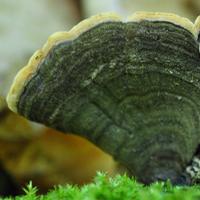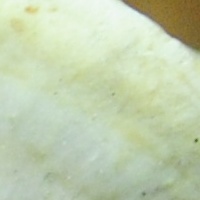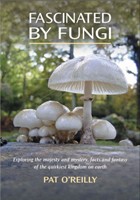Stereum subtomentosum Pouzar - Yellowing Curtain Crust
Phylum: Basidiomycota - Class: Agaricomycetes - Order: Russulales - Family: Stereaceae
Distribution - Taxonomic History - Etymology - Identification - Culinary Notes - Reference Sources
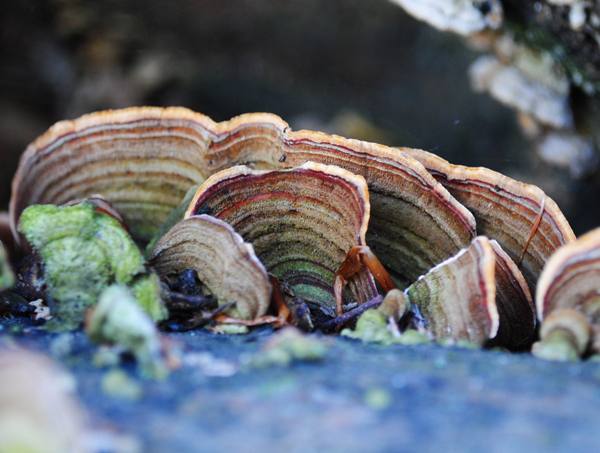
Easily confused with Trametes versicolor, the Turkeytail bracket fungus (which differs from Stereum species, however, by having tiny shallow pores on its fertile undersurface), this rather uncommon bracket grows on dead hardwood, and most commonly on Beech.
Like many other crust fungi, Stereum subtomentosum can be found throughout the year; however, its period of sporulation (releasing spores) is limited to the summer and autumn.
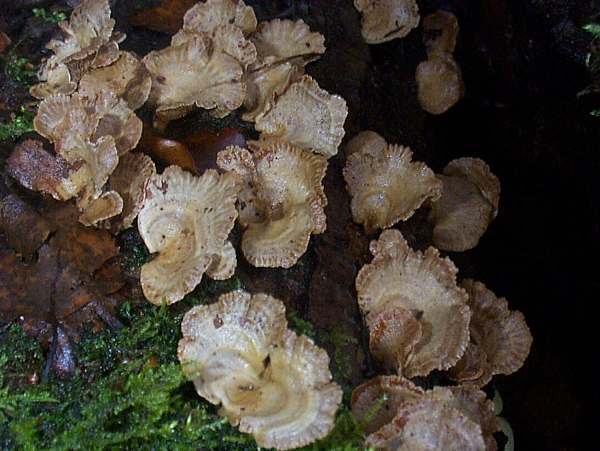
Distribution
Yellowing Curtain Crust is found throughout Britain, but it is most common in southern England and a much less frequent sight in Scotland and Wales. This species occurs also on mainland Europe, from Scandinavia down to Spain, and it has also been recorded in parts of North America.
Taxonomic history
This fungus was described as a unique species in 1964 and given its current scientific name Stereum subtomentosum by the Czeck mycologist and polypores specialist Zdeněk Pouzar (b. 1932). Prior to this it had been treated as a subspecies of other Stereum fungi - for example in 1874 Elias Magnus Fries referred to it as Stereum ochroleucum subsp. arcticum, which is now treated as a valid synonym of Stereum subtomentosum.
Etymology
Stereum, the generic name, means tough, and crust fungi in this genus certainly can be difficult to tear when you want to take a small sample for investigation. If you scratch the surface of this fungus it will turn yellow - hence the common name Yellowing Curtain Crust. The specific epithet subtomentosum comes from sub- meaning less than (in the sense of only slightly) and -tomentosum, meaning hairy or downy. Yellowing Curtain Crust is indeed much less hairy than Stereum hirsutum, which is known as Hairy Curtain Crust.
Identification guide
|
FruitbodyIndividual fan-shaped brackets are 3 to 7cm across and have irregularly wavy edges. The colours, which are zoned, are various shades of greyish-orange or greyish yellow. There is no stem, but the attachment region is usually quite narrow. |
|
The lower spore-bearing surface is smooth, without pores, and paler than the upper surface; it is less distinctly zoned and when bruised bleeds yellow. The flesh is 1 to 2mm thick. The absence of pores on the spore-bearing surface distinguishes Stereum from Trametes species, some of which may be similarly coloured on the upper surfaces. |
|
SporesSmooth, cylindrical to narrowly elliptical, often slightly allantoid, 5.5-8 x 2-3µm; amyloid; hyaline. Spore printWhite or very pale brown. |
Odour/taste |
No noticeable odour; tough, tasteless and inedible. |
Habitat & Ecological role |
On dead hardwood trees and fallen branches, usually beech. |
Season |
This bracket fungus can be seen all through the year; it sheds spores in late summer and autumn. |
Occurrence |
Fairly common in southern England; occasional in wales and Scotland. |
Similar species |
Trametes versicolor, with generally darker and bolder zones, is much more common. |
Culinary Notes
Tough and leathery, these tasteless fungi are inedible and of no culinary value.
Reference Sources
Fascinated by Fungi , Pat O'Reilly 2016
Dictionary of the Fungi; Paul M. Kirk, Paul F. Cannon, David W. Minter and J. A. Stalpers; CABI, 2008
Taxonomic history and synonym information on these pages is drawn from many sources but in particular from the British Mycological Society's GB Checklist of Fungi.
Acknowledgements
This page includes pictures kindly contributed by Attia Fodi.
Fascinated by Fungi. Back by popular demand, Pat O'Reilly's best-selling 450-page hardback book is available now. The latest second edition was republished with a sparkling new cover design in September 2022 by Coch-y-Bonddu Books. Full details and copies are available from the publisher's online bookshop...
